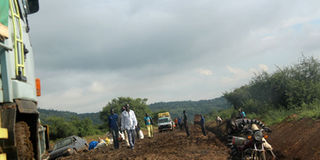How oil infrastructure will transform Bunyoro

To be improved. Cars stuck on the Hoima-Buliisa-Wanseko road. The road is one of the 10 oil roads that are planned to be tarmacked. PHOTO BY FRANCIS MUGERWA
What you need to know:
- According to the Bunyoro Affairs State minister, Mr Ernest Kiiza whose portfolio was created in 2012 to coordinate development activities in Bunyoro, government also plans to tarmac the Kabale–Kiziramfumbi road and rehabilitate Pakwach–Butiaba Ferry/barge to ease water transport.
- On June 21, the prime ministers from Ker Kwaro Acholi, Alur Kingdom and Bunyoro Kitara Kingdom launched the guidelines for oil companies operating in the Albertine graben.
Since commercially viable oil deposits were discovered on the shores of Lake Albert in mid-western Uganda, multi-billion dollar infrastructural projects have sprung up in Bunyoro Sub-region.
The oil-related projects have given mixed fortunes to the people in the area.
The already constructed infrastructure include roads, well pads and hydro-power dams while upcoming projects include the Kabaale International Airport, central processing facilities (CPFs) that will handle initial crude oil stabilisation and refining before crude is transported to the oil refinery, and the EACOP project that was on November 11 launched by President Museveni and the Tanzanian Foreign Affairs minister, Dr Augustine Mahiga, who represented president John Pombe Magufuli of Tanzania.
To facilitate commercial oil production, President Museveni said the government is going to build the oil roads in two years.
“Besides getting jobs, local communities will benefit from these roads and services such as electricity, water and hospitals that will be extended to the communities,” Mr Museveni said.
“I also thank the people of Bunyoro for the support, and urge you to cooperate with those building the pipeline. Be assured that you will benefit,” he said.
The 1445km long, 24-inch diameter pipeline that will be heated and buried underground will run from Hoima District to Port Tanga in Tanzania.
Government is currently surveying 10 critical oil roads that are up for tarmacking.
The roads include: Hoima–Butiaba–Wanseko, Masindi–Biiso, Masindi–Bugungu via Murchison Falls National Park, Kaseeta–Lweera via Bugoma Forest, Hohwa–Nyairongo–Kyarusesa, Wanseko–Bugungu, Buhimba– Nyarweyo–Kakindo–Kakumiro–Mubende, Lusalira–Nkonge–Sembabule and Kyotera–Rakai.
Others are Karugutu-Ntoroko (Via Semiliki National Park, Tangi Junction-Paraa in Nwoya District, including two bridges- Tangi and Emmi Bridge.
According to Ms Irene Muloni, Uganda’s Energy Minister, “This infrastructure will therefore not only support oil production but ensure inclusive development.”
Ms Muloni said the EACOP project’s lifecycle will also create more than 10,000 jobs, especially during the construction phase. The oil and gas infrastructure projects will create a combined total of 160,000 new jobs.
Boosting water transport
According to the Bunyoro Affairs State minister, Mr Ernest Kiiza whose portfolio was created in 2012 to coordinate development activities in Bunyoro, government also plans to tarmac the Kabale–Kiziramfumbi road and rehabilitate Pakwach–Butiaba Ferry/barge to ease water transport.

Promising. Hoima town central business district. With improved roads, the area is set to become an economic hub in the region. PHOTO BY FRANCIS MUGERWA
He said residents should increase farm productivity to cater for a ready market that will be provided by oil workers, contractors and new businesses in the area.
He said more than 30 per cent of the area population lives below the poverty line compared to National Average of 24 per cent (Ubos, 2014) thus requiring interventions to address the situation.
“With the discovery of oil in the region, fighting poverty is of paramount importance in order to prevent likelihood of social conflicts among some sections of the community,” he added.
Agriculture is the mainstay of the people in Bunyoro Sub-region although only 12 per cent of the arable land is currently cultivated, said Kiiza who is also a businessman and Masindi Municipality MP.
Impact of infrastructure
However, along the road, industries have been established, warehouses, expanded townships and roadside markets, which are improving people’s incomes.
The oil infrastructure projects have given local people in Bunyoro Sub-region job opportunities while those, who are affected by the projects have been compensated.
The opportunities created by the oil infrastructure have attracted many people from various parts of the county and abroad into the area as investors, employers and employees while others are suspected criminals and prostitutes.
The investors in the region are creating jobs and setting up new projects that are boosting tourism, hospitality, housing and trade.
Cultural concerns
The new comers into the region have affected oil-rich cultural institutions.
On June 21, the prime ministers from Ker Kwaro Acholi, Alur Kingdom and Bunyoro Kitara Kingdom launched the guidelines for oil companies operating in the Albertine graben.
The guidelines were developed to protect and promote the cultural rights of the oil affected communities in Bunyoro Kitara Kingdom, Alur Kingdom and Ker Kwaro Acholi.
Oil and gas discoveries have raised hopes of social-economic prosperity as well as fears. The guidelines are designed to ensure that such hopes are realised and the obstacles are overcome, the premiers added.
According to the cultural institutions, land is central to their cultural identity and economic wellbeing.
Given the history of land dispossession in some areas, cultural institutions noted with alarm the growing threat of land speculation, immigration, targeting land for oil infrastructure development leading to dispossession and tension between local communities and new land owners.
“The rapid transition of customary land into freehold is some areas is of further concern as it leads to exclusion of communities from common lands and resources,” the leaders said.
The oil-rich Albertine graben has various cultural sites which include graveyards, shrines, monuments, natural sacred sites and other ecological features, some of which have been affected by oil infrastructure.
However, oil firms argue that they try to avoid degrading cultural sites and where it is inevitable for them to avoid operating on cultural sites, they mitigate the effects.



